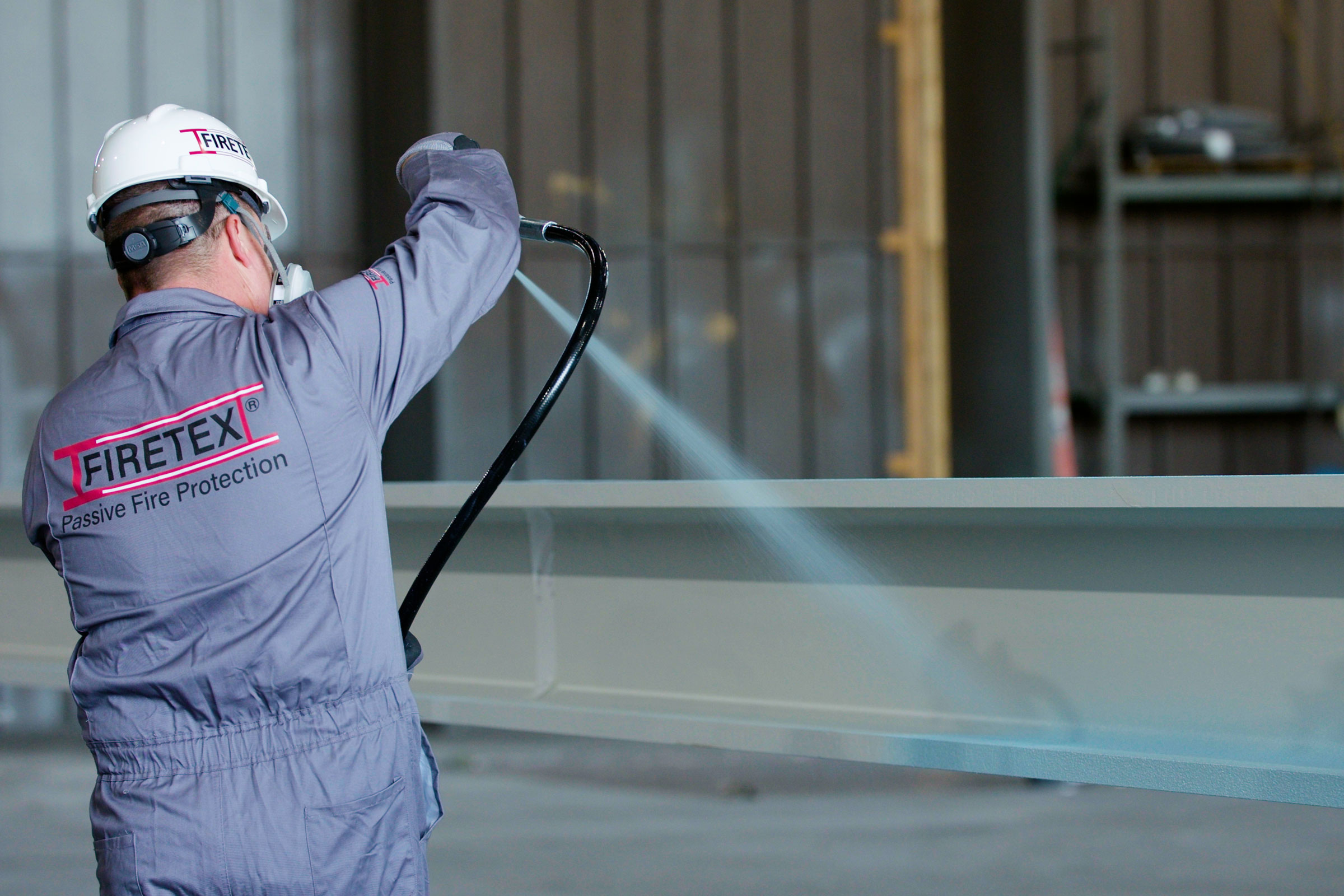Story at a glance:
- Global warming potential, or embodied GHG emissions, can be reduced in many ways.
- Switching to renewable energy sources is the most effective way to reduce global warming potential.
- Other strategies include passive design, choosing low-carbon materials, reusing products, and installing energy-efficient appliances.
When it comes to global climate science and policy, the 1.5℃ threshold—Earth’s average surface temperature warming of 1.5℃ above pre-industrial temperatures—represents the point at which the adverse effects of global warming become functionally irreversible.
If we hope to keep global warming below this threshold, we need to transition away from the burning of fossil fuels and drastically reduce the amount of greenhouse gasses that are being emitted.
And while this is no easy task, there are many ways to reduce the embodied carbon or global warming potential of various industries, businesses, buildings, and products. We’ll explore 10 of them in this article.
What is Global Warming Potential?

Outside of the realm of climate science, the term “global warming potential” is colloquially used to refer to the embodied GHG emissions of a product, building, industry, et cetera. Photo by Kevin Scott
When scientists talk about global warming potential (GWP), they’re referring to an index used to measure how much infrared thermal radiation a specific greenhouse gas will absorb over a given period of time once it has entered the atmosphere. This is the definition used by the International Panel on Climate Change and informs most international GHG accounting efforts.
The International Organization for Standardization (ISO), however, also uses the term GWP, defining it as an impact category that refers to the total embodied GHGs of a product, building, or process throughout its life cycle. In this regard, it is more accurate to think of ISO’s GWP as the lifetime embodied GHG equivalent or embodied GHG footprint of a product, building, or process. This particular usage of GWP appears in Environmental Product Declarations, Product Category Rules, and other related programs.
For the purposes of this article, all further mentions of GWP will loosely correspond with ISO’s definition unless stated otherwise.
10 Tips for Reducing Global Warming Potential
There are many ways to reduce embodied GHG emissions and GWP. We’ve outlined 10 of them below.
1. Make the Switch to Renewable Energies
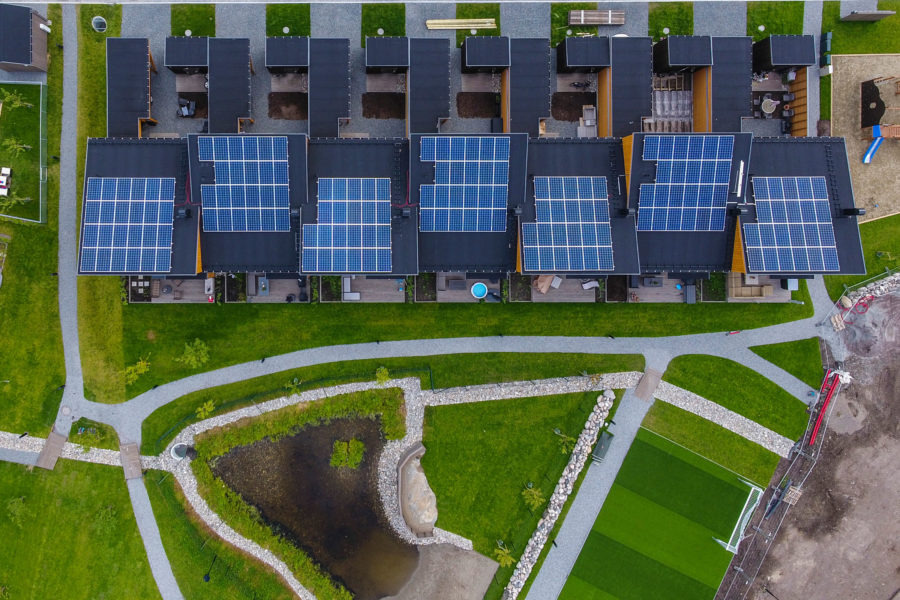
Transitioning away from fossil fuels and embracing renewable energies is the most effective way to reduce GWP. Photo courtesy of Otovo
The most effective way to reduce global warming potential is by making the switch from fossil fuels—the single largest contributor to anthropogenic climate change—to green, renewable energy sources.
Transitioning the globe’s power grids to cleaner, renewable energy sources like solar, wind, hydro, geothermal, and even nuclear power is one of the single most effective ways to reduce GHG emissions by a significant margin in a relatively short amount of time. Making the switch to renewable energy also means investing in large-scale electricity storage, particularly for intermittent energy sources like solar and wind that are not available at all times.
2. Embrace Electrification
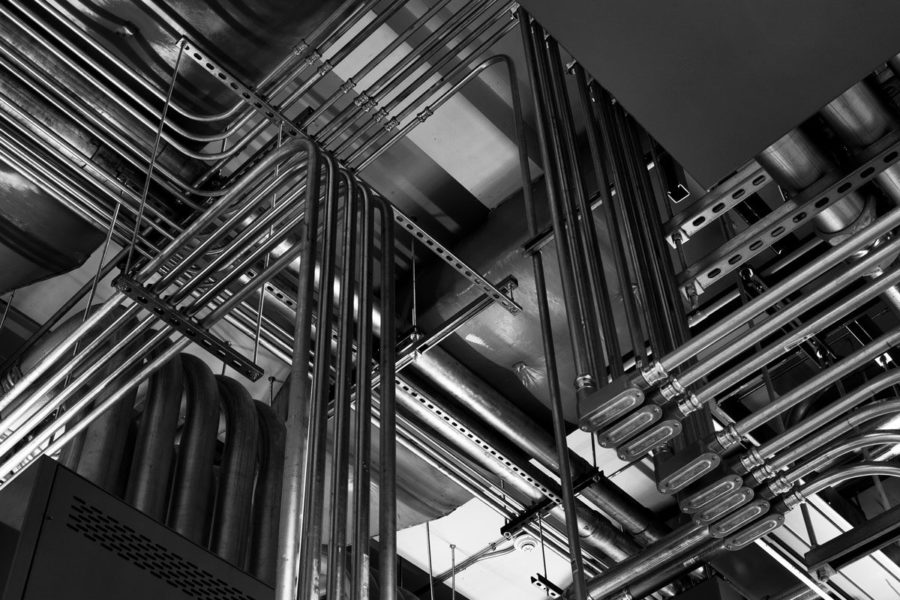
The steel industry is reducing the GWP of hot-rolled steel by replacing traditional blast furnaces with electric arc furnaces. Photo courtesy of Steel Tube Institute
Electrification refers to the process of actually replacing existing end-use technologies powered by the burning of fossil fuels—e.g. gas boilers, internal combustion engines, furnaces, et cetera—with technologies that use clean electricity as a more sustainable source of energy.
Electric vehicles are perhaps the most well-known example of current electrification efforts but work is being done in other sectors as well. The US steel industry, for instance, has started the process of electrification by manufacturing all hot-rolled steel sections via electric arc furnaces. These furnaces use electricity to melt steel scrap into new steel and produce 75% less CO2 emissions than traditional blast furnaces, which burn coke—a coal-based fuel with an extremely high carbon content—to smelt iron ore.
3. Opt for Cleaner-Burning Fuels

Geneva Rock Products’ fleet of compressed natural gas trucks emit 90% less carbon than traditional diesel trucks. Photo courtesy of Geneva Rock
In instances where electrification simply isn’t possible, feasible, or realistic—such as in long-haul trucking, inter-ocean cargo shipping, planes, and many industrial processes—fossil fuels should be replaced with cleaner-burning fuels like compressed natural gas, green hydrogen, electrofuels, and biofuels to reduce GWP.
Green hydrogen is a fuel created via electrolysis and involves splitting the oxygen and hydrogen molecules in water. As long as the electrolysis process is powered by clean, renewable electricity, green hydrogen is a virtually carbon-free alternative to traditional fossil fuels.
Electrofuels—or E-fuels—on the other hand, are synthetic carbon-based fuels designed to replace conventional drop-in liquid fossil fuels like diesel and methanol. Electrofuels are produced using captured carbon dioxide or carbon monoxide and hydrogen obtained from water split by clean electricity sources. When burned, electrofuels produce roughly the same amount of carbon used in their manufacturing, essentially making them carbon neutral. E-fuels are a viable option for reducing GHG emissions produced by air, marine, and long-distance freight transportation.
Biofuel is another cleaner-burning alternative to conventional fossil fuels and is produced from biomass derived either from plants or agricultural, industrial, or domestic bio-waste. Like E-fuels, biofuels are considered carbon-neutral as the only carbon they emit is that which was sequestered by the organic matter used to produce them.
4. Incorporate Passive Design Principles

The LEED Platinum Urban Frontier House is extremely energy efficient thanks to its use of passive design strategies. Photo by Clark Marten
GWP can be reduced even further by making energy efficient upgrades to a product, building, or manufacturing process so that it requires less electricity in the first place. When it comes to the built environment, incorporating passive design principles—like those identified by the International Passivhaus Institute or PHIUS—is one of the most effective ways to improve energy efficiency and reduce lifetime emissions.
Some of these strategies include:
Air Sealing
Air leaks account for approximately 25 to 40% of the energy used to cool and heat a building, according to Energy Star. Even worse, air leaks can also significantly reduce the effectiveness of a structure’s other energy-saving features, leading to the waste of energy, time, and money.
Some of the most effective air-sealing measures include the use of high-quality weather-stripping, caulking, liquid flashing membrane, joint and seam fillers, air and water resistant barriers, and stainless steel fabric flashing. PROSOCO is one of the leading manufacturers of air-sealing products and has worked on several passive house projects. The company’s facility houses a custom-engineered testing chamber that is available for external use by engineers, building scientists, and window manufacturers to optimize the air- and water-sealing capacity of their building components.
Selecting Proper Insulation
Insulation is a building’s first line of defense when it comes to preventing unwanted heat transfer—and while all buildings require some amount of insulation in order to meet code requirements, not all insulation is created equally. For peak energy efficiency, organizations like PHIUS recommend installing continuous and/or superinsulation, the latter of which is defined as insulation with an extremely high R-value (e.g. R-40 for walls, R-60 for roofs).
Continuous insulation, on the other hand, is exactly what it sounds like—an uninterrupted layer of insulation that envelopes an entire structure. Continuous insulation is typically installed between a building’s framing system and its exterior cladding, though it can be incorporated into the framework itself by way of structural insulated panels (SIPs) or insulated concrete forms (ICFs).
When combined with an airtight envelope and heat recovery ventilation systems, continuous superinsulation allows a structure to rely primarily on intrinsic heat sources (e.g. body heat of occupants and waste heat from appliances), greatly reducing the need for supplementary mechanical heating.
The HPA-designed Urban Frontier House in Billings, Montana, for example, employs overlapping SIPs in conjunction with passive ventilation and circulated sun-warmed air to passively regulate interior temperatures. These elements are so effective, in fact, that the home does not even possess a mechanical heating and cooling system despite outdoor temperatures ranging between -36 and 108℉ throughout the year.
Eliminating Thermal Bridges
Even air-sealed buildings with high R-value insulation can waste energy by way of thermal bridges, or weak areas (e.g. wall studs, floor-to-wall and wall-to-ceiling junctions, fasteners, et cetera) in the envelope where heat is allowed to pass through from one side to another with little resistance. Thermal bridging can be responsible for as much as 30% of a building’s heat loss and greatly reduces the total R-value of wall and roof assemblies; thermal bridges created by wooden wall studs, for example, can reduce R-value by anywhere from 14 to 63%.
And while it is technically impossible to completely eliminate thermal bridges from a building’s design, it is possible to reduce them to the point where they have a negligible impact on energy waste. This is achieved through the strategic placement of thermal breaks, or construction components that have a low thermal conductivity and high thermal resistance.
The aforementioned continuous insulation is one of the most effective means of preventing thermal bridging in wall assemblies, whereas Schöck’s catalog of Isokorb thermal breaks can be used to prevent thermal bridging at balcony and awning connection points as well as rooftop penetrations like dunnage supports, davits, and the like.
5. Design for Walkability

The block-long Collection 14, designed by Perkins Eastman, was designed for walkability and places residents in close proximity to several public transit options, reducing the need for personal vehicles. Photo by Andrew Rugge
Transportation accounts for approximately 29% of all carbon emissions in the United States, with light-duty passenger vehicles being responsible for more than half of that figure. This is a direct consequence of urban planners prioritizing car-centric infrastructure over people-centric infrastructure, a switch that began in the 1950s and has persisted to this day.
Architects, developers, and urban planners can help reduce GWP by designing for walkability—that is, by replacing car-centric infrastructure with infrastructure that supports or encourages walking, bicycling, and other alternative modes of transportation. This includes things like expansive sidewalks and pathways, bicycle lanes, interconnected trail networks, benches and covered rest areas, wayfinding tools, adequate lighting, et cetera.
Designing for walkability also means providing pedestrians with access to a variety of reliable public transit options. Perkins Eastman’s mixed-use Collection 14 project, for example, is a walkable community that spans an entire city block in Washington, D.C. and boasts close proximity to several public transportation networks.
“The location of this project is a big part of the sustainability story,” Heather Jauregui, Perkins Eastman’s director of sustainability, previously told gb&d. “Collection 14 is a block from the Metro and has great bus lines. If you design a high-performance building, but it’s in the middle of nowhere and everyone has to drive there, is it really sustainable?”
6. Reduce, Reuse, Recycle

Adaptive reuse can help reduce the embodied carbon of a project by an average of 40%. The Bakar BioEnginuity Hub, for example, now calls a former Berkeley Art Museum building home—a building that was in danger of being demolished until further review by MBH Architects. Photo by Bruce Damonte Photography
The manufacturing of new products is a major source of GHG emissions—in 2021 alone, the Congressional Budget Office estimated that the US manufacturing sector generated 765 million metric tons of CO2e. This is largely the result of a society who’s economic system is based around the linear “take, make, and throw away” model of production and consumption.
“Excessive waste is the unfortunate byproduct of a consumer culture that grew during a time when the world did not understand the perils of overconsumption,” Richard Skorpenske, head of sustainability and public affairs at Covestro, previously wrote for gb&dPRO. “Through a combination of market forces, design trends, and consumer demand, an ‘extract, use, discard’ cycle became the dominant mode of manufacturing and consumption.”
Adopting elements of a circular economic model, however, can help to reduce these manufacturing-related emissions by keeping products and materials in circulation for as long as possible. This is done by prioritizing the sharing, reuse, repair, refurbishment, and recycling of products as opposed to discarding them once they’ve reached the end of their perceived operational lifespan.
This concept can even apply to entire buildings, a process commonly referred to as adaptive reuse. Defined as the reuse of existing buildings for purposes other than what they were originally constructed for, adaptive reuse necessitates less demolition work, requires fewer new materials, and can help reduce a project’s embodied carbon by an average of 40%.
“Less demolition means less environmental pollutants resulting from the demolition itself, less debris going into landfills, and less energy required as part of the overall reconstruction process,” Tom Pflueger, studio director of MBH Architects, previously wrote for gb&d. “It also decreases emissions from the transportation of debris, both to landfills or to be repurposed, and of new resources to the job site. By reusing existing materials, adaptive reuse projects can decrease energy usage and pollution resulting from the manufacturing and transportation of new materials.”
7. Choose Low-Carbon Materials
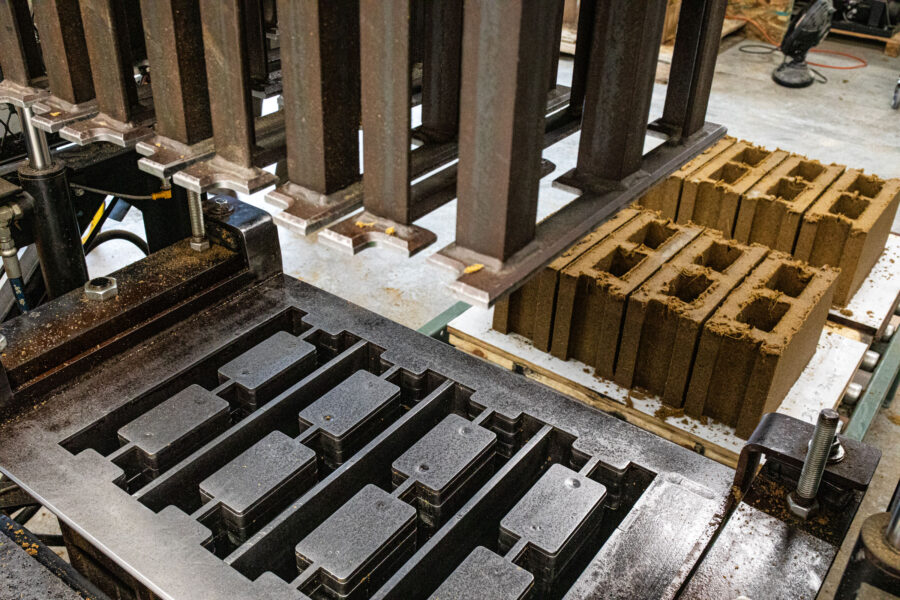
To reduce embodied emissions and GWP within the AEC sector, construction professionals should select low-carbon materials. Photo courtesy of Prometheus Materials
Reusing and repurposing materials for construction is ideal, but it isn’t always possible. When it comes to new materials, the AEC sector can work to reduce GWP by selecting low-carbon building materials for construction and infrastructure projects. This includes materials that are naturally low-carbon—like mass timber, bamboo, rammed earth, et cetera—as well as low-carbon versions of traditionally high-carbon materials, like concrete.
Prometheus Materials, for example, has developed a zero-carbon alternative to limestone-based concrete called ProZero. ProZero is created by stimulating microalgae to create biomineralized calcium carbonate—the same process that creates coral reefs and seashells—that is then dried and used as the basis for bio-cement. In this manner ProZero avoids the carbon-intensive operations involved in manufacturing traditional cement. Microalgae also absorbs carbon as it grows, meaning ProZero sequesters carbon throughout its operational lifespan, reducing its carbon footprint even further.
ProZero is 15 to 20% lighter, possesses comparable compressive strength, and far exceeds the flexural strength of conventional concrete. “This degree of flexural strength will open up quite a few new market opportunities that traditional concrete just can’t fulfill,” Loren Burnett, president, CEO, and cofounder of Prometheus Materials, previously told gb&d.
8. Source Food Locally & Eat Less Meat

The Farm at Serenbe provides residents and nearby restaurants with local, organic produce. Photo courtesy of Serenbe
Studies suggest that global food transportation generates almost 20% of all food-related emissions, with produce transported by air freight being the worst offender. Sourcing food locally is one way to reduce these so-called “food mile” emissions while also supporting local businesses.
The Serenbe wellness neighborhood in Georgia, for example, is home to an organic farm that provides residents and local restaurants with fresh produce via a community supported agriculture (CSA) farm share program. CSA members are allowed to receive up to seven items (or approximately 5 to 10 servings of vegetables) each week during the growing season for only $20 to $30. Aside from reducing GWP, sourcing food from local farms also helps stimulate local economies and supports healthy community-building efforts.
Making changes to one’s diet can also help reduce GWP. Livestock like cows and other ruminants, for example, are a major source of methane, a greenhouse gas that is over 28 times as effective as CO2 at trapping heat in the atmosphere. Cutting down on meat and dairy consumption or adopting a wholly vegetarian lifestyle can reduce a person’s CO2e footprint by approximately 500 kilograms per year.
9. Support Surface Transport Over Air Travel
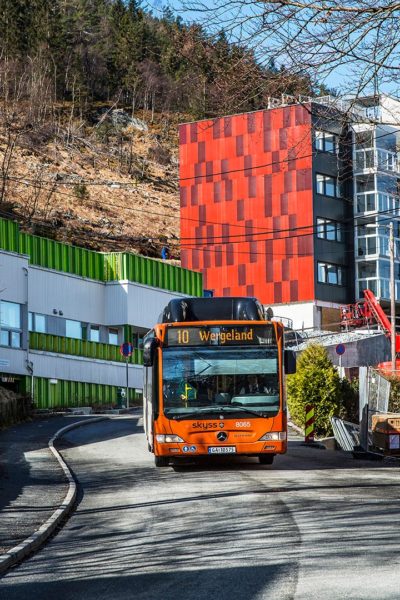
Surface transport options like buses, trains, and high-speed rail emit far fewer emissions per passenger per mile than planes. Photo courtesy of Arkitektgruppen Cubus AS
When it comes to the amount of CO2 emitted per person, flying is by far one of the most polluting means of transportation. Exact amounts vary depending on the type of plane, weather conditions, and route, though the National Energy Foundation estimates an average of roughly 0.29 kg of CO2 emitted per passenger per mile. This translates to an approximate total of 53 pounds of CO2 emissions per mile per flight, according to BlueSkyModel.
Supporting the development of—and actually utilizing—surface transport options like subways, trains, light- and high-speed rail, and buses is one of the most effective ways to reduce transport-related GHG emissions. Taking a train, for example, produces 80 to 90% fewer CO2 emissions compared to the same trip via a plane, while high-speed rail emits seven times fewer CO2 emissions per passenger kilometer than an airplane.
10. Install Energy-Efficient Appliances

Reduced plug loads, a wider indoor temperature range, enthalpy wheel heat recovery, and energy-efficient filtered fume hoods are among the green building features in the John J. Sbrega Health and Science Building. Photo by Edward Caruso
Another simple way to reduce GWP is by investing in energy-efficient appliances. Today you can find an energy-efficient version of just about any major appliance—be it a refrigerator, oven, dishwasher, stove, washing machine, dryer, et cetera—and many building systems, including HVAC, radiant heating and cooling, and more.
There even exist energy-efficient models of specialized equipment for labs and health care spaces. Bristol Community College’s net-zero John J. Sbrega Health and Science Building, for example, makes use of energy efficient filtered fume hoods in all of its labs as part of the college’s commitment towards achieving carbon neutrality by 2050.
“I’ve had people ask me why the chemistry building is the place to reduce energy, when safety is paramount,” Thomas Simister, a senior associate at Sasaki, previously told gb&d. “I would completely agree with that, but also say that unless we push ourselves technologically and behaviorally, we’re not going to make a dent in our energy consumption overall. There are ways to reduce energy smartly, even in science buildings like these.”
If you’re having trouble determining whether an appliance is efficient, check to see if it bears an ENERGY STAR label. If it does, the appliance has been deemed energy-efficient according to guidelines set by the EPA or the DOE. In most cases ENERGY STAR appliances significantly exceed federal standards for both quality and efficiency, which means they’re likely to last longer, too.


